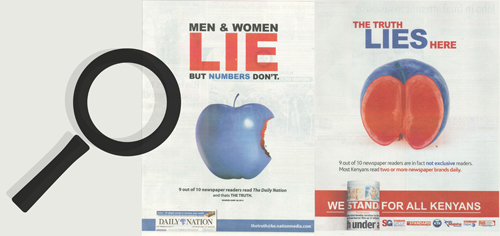 The never ending heated competition between The Standard and The Nation has gone a notch higher with both newspapers using data to try to convey the message that their position in the market is strong.
The never ending heated competition between The Standard and The Nation has gone a notch higher with both newspapers using data to try to convey the message that their position in the market is strong.
It began when The Nation of July 23 carried an advert which claimed that, “nine out of 10 newspaper readers read The Daily Nation” a number that originates from quarterly reports by Kenya Advertisers Research Foundation.
A few days later The Standard fired a salvo back with a similar looking advert but which quoted another fact from the same study which said that 9 out of 10 newspaper readers are not exclusive readers, but read two or more newspapers daily.
So, where does the truth lie? When it comes to data the two facts do not have to contradict each other.
On one hand it is likely that a big chunk of The Nation readers also read other newspapers, but this does not take away from the fact that most newspaper consumers read The Nation more than any other newspaper.
The Standard insinuates in their advert that the readers read both The Standard and The Nation. But the more likely scenario is that some are readers of The Nation and The Star, or perhaps The People and The Star.
The truth is that both media houses are portraying data that favors them while ignoring information that flatters their competitor.
Contrary to the declining trend of newspaper readership in other countries, in Kenya the dailies have experienced increase in circulation for the last five years. New readers mean more advertising revenue, and this is what The Nation and The Standard are really fighting about.
According to the Economic Survey 2013, the copies of newspaper bought last year grew by 2.4 per cent. In total more than 110 million copies of daily newspapers were printed in 2012, which amounts to about 300,000 copies sold per day.
When it comes to data, the devil is in the detail. Who commissioned the study? what are the interests of that organization? To commission a proper study is expensive so private sector organizations like Kenya Advertisers Research Foundation usually have their own interests.
When analyzing data a journalist should find who carried out the survey. There are many companies who do marketing research but not all of them are credible. What method did they use? How were the questions formulated, how many readers were interviewed and in which areas?
But when the collection of data is privately funded journalistic problems arise.
Under such conditions it is hard for independent journalists to find their own conclusion of what the truth is, if at all.
Advertising itself is all about portraying a product as attractive, telling the most positive facts and shoveling the less charming under the rug. So, when data comes from advertisers, how much can we really trust?
In the US, infographics have become more and more popular as a tool for marketers. The eye friendly graphics present fun facts, and are widely shared on social media, driving up the hits on the websites of the companies that commissioned them. This new urge for well-presented fun information has turned into a “boom” with specialized infographics firms popping up like mushrooms on the other side of the Atlantic.
Here in Kenya there is also an urge for information as Kenyans spend more and more time on the Internet. According to theCommunications Commission of Kenya, in April this year, about one out of four Kenyans now access the Internet, which is an increase of 75 percent compared to a year earlier.
Two years ago, retired president Kibaki launched the Kenya 0pen Data Initiative, which was to give Kenyans access to public data. There has been some progress, but a lot needs to be done. Still most public institutions in Kenya tend to only want to make public the data that flatters them, just like the adverts from the two competing dailies.

